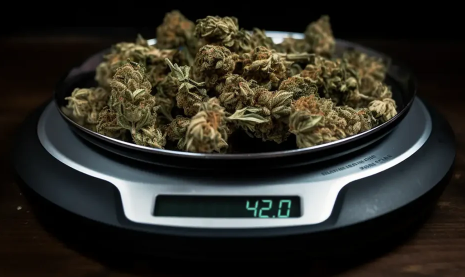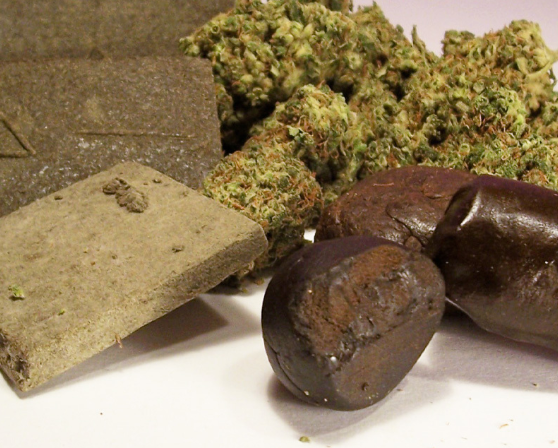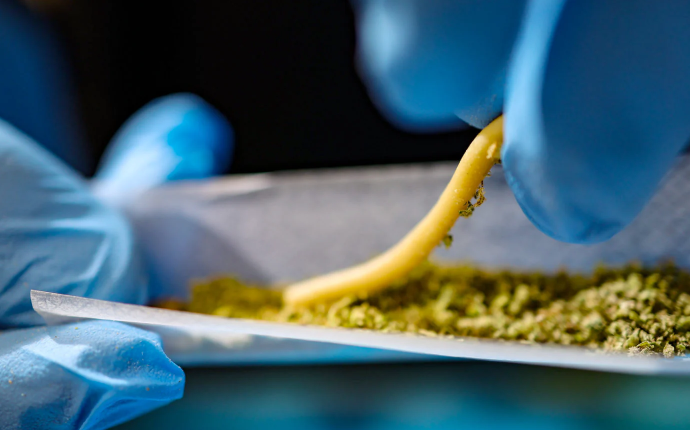Navigating the world of cannabis can be a daunting task, especially when it comes to understanding the various measurements and quantities involved. Whether you're a seasoned smoker or a newcomer to the herb, being familiar with the standard units used to quantify weed is essential for making informed purchasing decisions and ensuring you get your money's worth.
In this comprehensive guide, we'll delve into the intricacies of weed measurements, exploring the common terms and conversions that are widely used in the cannabis industry. From grams and ounces to quarters and pounds, we'll equip you with the knowledge to confidently engage with budtenders, online dispensaries, and fellow enthusiasts.
Decoding the Metric System: Understanding Weed Measurements
In the United States, the cannabis industry predominantly utilizes the metric system to measure weed, despite the country's general preference for the imperial system. This can be a source of confusion for some, but understanding the conversion between grams and ounces is the key to navigating the world of weed measurements.
Grams: The Fundamental Unit
The basic unit of measurement for weed is the gram (g). This metric measurement is used universally, even in the United States, to ensure consistency and standardization across the industry. One gram of cannabis typically equates to a medium-sized bud or a small handful of buds, depending on the density and quality of the flower.
Ounces: The Imperial Equivalent
While grams are the standard unit, the imperial system's ounce (oz.) is also commonly used, especially by consumers and retailers. One ounce of weed is equivalent to 28 grams, making it a more substantial quantity for those seeking larger amounts.
Fractions and Multiples: Exploring the Measurements
Beyond the gram and ounce, there are several other commonly used measurements in the cannabis world. These include:
- Eighth (⅛) Ounce: Equivalent to 3.5 grams, this is a popular purchase size for casual users and those looking to sample new strains.
- Quarter (¼) Ounce: Equivalent to 7 grams, a quarter ounce provides a more substantial quantity for regular users.
- Half (½) Ounce: Equivalent to 14 grams, a half ounce is a larger purchase size that can last for several weeks, depending on consumption habits.
- Ounce: As mentioned earlier, one ounce is equal to 28 grams, making it a substantial amount for those who prefer to buy in bulk.
- Pound: The largest commonly used measurement, a pound of weed is equivalent to 453.592 grams or 16 ounces.
Understanding these conversions and the corresponding quantities can help you make informed decisions when purchasing cannabis, ensuring you get the right amount for your needs and budget.

Navigating the Legal Landscape: Quantity Limits and Regulations
When it comes to cannabis, it's crucial to be aware of the legal landscape in your state or jurisdiction. Many states have implemented laws that regulate the maximum amount of weed an individual can possess or purchase at a given time. Exceeding these limits can result in legal consequences, so it's important to familiarize yourself with the relevant regulations.
For example, in New York, the legal limit for personal possession is three ounces of cannabis flower or 24 grams of cannabis concentrate. In contrast, some states, such as Colorado, allow for the possession of up to one ounce of weed. It's essential to research and stay up-to-date with the laws in your area to ensure you're operating within the legal boundaries.
By understanding the various weed measurements and their corresponding legal limits, you can make informed decisions and avoid any potential legal pitfalls.
Buying Weed: Navigating Dispensaries and Online Platforms
Whether you're visiting a local dispensary or exploring online cannabis marketplaces, being familiar with weed measurements can greatly enhance your shopping experience. Knowing the common terms and quantities can help you communicate effectively with budtenders, ensure you're getting the right amount, and make informed purchasing decisions.
Dispensary Purchases: Communicating with Budtenders
When visiting a dispensary, you'll often encounter budtenders who are well-versed in the intricacies of weed measurements. Being able to articulate your desired quantity in terms of grams, ounces, or fractions thereof can streamline the process and help the budtender provide you with the appropriate product.
Online Weed Purchases: Knowing What to Expect
Buying cannabis online presents a unique set of challenges, as you don't have the opportunity to physically inspect the product before making a purchase. Understanding the standard weed measurements can help you determine the appropriate quantity to order and ensure you receive the correct amount.
When browsing online dispensaries or marketplaces, pay close attention to the product listings, which should clearly indicate the weight or quantity of the cannabis being offered. This information, coupled with your knowledge of weed measurements, will allow you to make informed decisions and avoid any surprises or disappointments upon delivery.
Ensuring Accurate Measurements: Weighing and Verifying
While reputable cannabis retailers and online vendors strive to provide accurate measurements, it's always a good idea to verify the weight of your purchase. Investing in a reliable digital scale can be a game-changer, allowing you to cross-check the stated quantity and ensure you're getting what you paid for.
Utilizing Digital Scales
Digital scales designed for weighing cannabis are readily available and can be a valuable tool in your arsenal. These precise instruments can accurately measure the weight of your weed, down to the decimal point, providing you with the confidence that you're receiving the correct amount.
Comparing to Common Weights
If you don't have access to a digital scale, you can use a simple technique to estimate the weight of your weed. By comparing the size and heft of your purchase to common household items, you can get a rough idea of the quantity. For instance, one gram of weed is roughly the same weight as a grape, while an eighth ounce (3.5 grams) is similar to a medium-sized kiwi fruit.
Calculating Consumption and Budgeting
Knowing the precise measurements of your weed can also help you plan your consumption and budget accordingly. Understanding the number of joints, bowls, or edible servings you can derive from a given quantity can assist you in managing your stash and ensuring it lasts as long as needed.
Estimating Consumption
As a general rule of thumb, a gram of weed can typically roll 1-2 full-sized joints or provide several smaller servings. An eighth ounce (3.5 grams) could yield around 3-7 joints, while a quarter ounce (7 grams) could translate to 7-14 joints. By keeping these estimates in mind, you can better gauge how long your weed will last based on your consumption patterns.
Budgeting and Cost Considerations
The cost of weed can vary widely depending on factors such as location, strain, and quality. Understanding the typical prices for different weed measurements can help you budget your cannabis expenditures effectively. For instance, a gram of weed may cost anywhere from $10 to $20, while an eighth ounce can range from $30 to $70. By keeping these price points in mind, you can make informed decisions about the quantity you purchase and ensure you're getting the best value for your money.
Storing and Preserving Your Stash
Proper storage and preservation techniques can help maintain the quality and potency of your weed, ensuring you get the most out of your purchase. Understanding the ideal conditions for storing cannabis can extend the lifespan of your stash and prevent premature degradation.
Airtight Containers and Humidity Control
Storing your weed in airtight containers, such as glass jars or specialized cannabis storage solutions, is crucial for preserving freshness. Additionally, maintaining the right humidity levels, typically between 55% and 62%, can help prevent the weed from drying out or becoming overly moist.
Temperature and Light Considerations
Exposure to excessive heat, sunlight, or moisture can degrade the cannabinoids and terpenes in your weed, diminishing its potency and flavor. Keeping your stash in a cool, dark, and dry environment, such as a dedicated cannabis storage cabinet or a drawer, can help preserve the quality of your cannabis.
Exploring Edibles and Concentrates
While the traditional method of consuming cannabis is through smoking or vaping, the cannabis industry has expanded to include a wide range of alternative products, including edibles and concentrates. Understanding the potency and dosing of these products is crucial, as they can have significantly different effects compared to traditional flower.
Edibles: Calculating Serving Sizes
Edibles, such as gummies, baked goods, and tinctures, are typically measured in milligrams (mg) of THC or CBD. Understanding the appropriate serving size for your needs is essential, as the effects of edibles can be more potent and long-lasting compared to inhalation methods.
Concentrates: Potency and Dosing
Cannabis concentrates, including oils, waxes, and shatters, are highly potent products that require careful consideration. These products are often measured in terms of milligrams (mg) or percentages (%) of THC or CBD, and it's important to start with small doses and gradually increase as needed to avoid unwanted side effects.
Staying Informed and Adapting to Changes
The world of cannabis is constantly evolving, with new strains, products, and regulations emerging regularly. Staying informed and adapting to these changes is crucial for ensuring you continue to make informed decisions and get the most out of your cannabis experience.
Monitoring Industry Trends and Developments
Follow reputable cannabis news sources, industry publications, and online communities to stay up-to-date with the latest trends, product innovations, and regulatory changes. This knowledge will empower you to make informed choices and stay ahead of the curve.
Embracing Flexibility and Adaptability
As the cannabis landscape continues to evolve, be prepared to adjust your understanding and approach to weed measurements. Be open to learning new terms, exploring alternative products, and adapting your consumption habits to ensure you're always getting the most value and satisfaction from your cannabis experiences.
Conclusion
Navigating the world of weed measurements can seem daunting at first, but with the knowledge and insights provided in this comprehensive guide, you'll be well-equipped to make informed decisions, communicate effectively with industry professionals, and ensure you're getting the most out of your cannabis purchases.
Remember, understanding the various units of measurement, legal regulations, and storage best practices will not only enhance your overall cannabis experience but also help you become a more savvy and responsible consumer. Embrace the knowledge, engage with the community, and embark on your cannabis journey with confidence and clarity.





